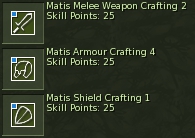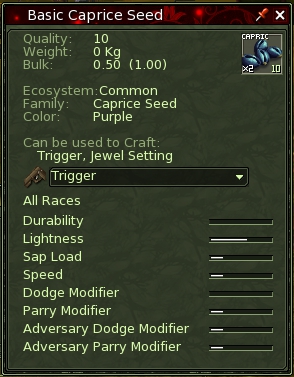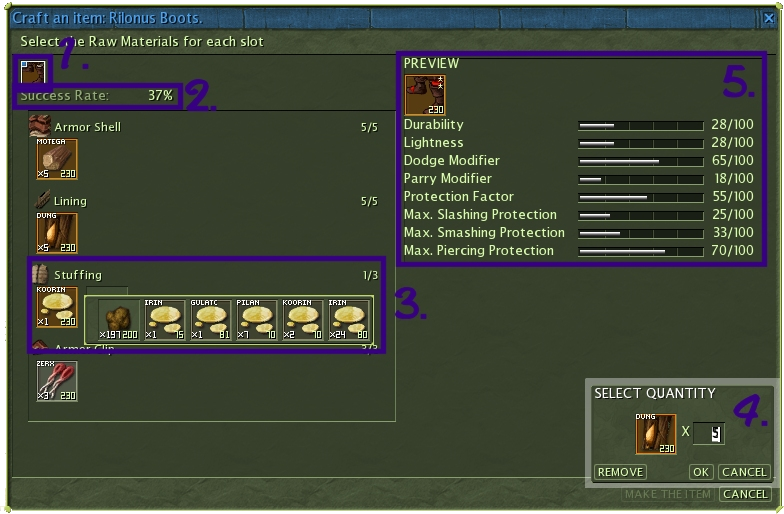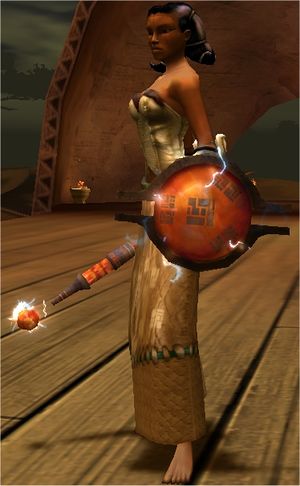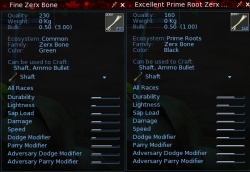From EncyclopAtys
In Ryzom, crafting is a fascinatingly complex system, with many little oddities and facets of interest for those willing to be constantly baffled in the name of science. Player-crafted equipment is, without doubt, the best equipment available ingame - equipment sold on the vendors by NPCs, and even Bandit Lord loot equipment, pale in comparison. As such, crafting is central to Ryzom; no warrior or mage can get by without a good player crafted weapon or set of amps; and materials used in crafting are the main currency of the Ryzom economy. Large guild battles are fought in the most perilous corners of Atys, for the privilege of having first pickings of the most valuable crafting materials.
Crafting in Ryzom is very different from crafting in most other games, so for many new players it entails a steep learning curve; there is much, much more to crafting than having the levels to craft high quality gear. Someone who has maxed their crafting tree can easily still be a bad crafter. However, the rewards are well worth the effort.
It is recommended that, in addition to reading this guide, new players do the tutorial missions from Sterga Hamla on Silan; as these provide an excellent hands-on crash course regarding the basics of crafting.
Getting Started
As crafting in Ryzom is so complex, the first section of this article addresses only the very basics. Once you've got a good grasp on these, you might want to read the Advanced Crafting section below - but do remember to use this guide sparingly; half the fun is in figuring it out yourself.
So, what do you need to get started with crafting in Ryzom?
Stanzas and Plans
Before you can craft anything, you need both a stanza for the item category you want, and a plan for the particular kind of item you wish to craft. Both of these can be bought from a Crafter Trainer.
There are four main skill trees (and item categories), each of which is accompanied by a stanza set:- Armour crafting - including shield crafting at level 51+.
- Melee Weapon crafting - believe it or not, this includes magic amplifiers.
- Jewel crafting
- Range crafting - this is for crafting guns and ammo, and is not available on Silan.
In addition, there is one less obvious crafting type:
- Tool crafting - You cannot craft regular tools with tool crafting. Tool crafting is used to make special tools out of outpost materials, as explained in Special Tools & Boosted Crafting. It is recommended that you don't buy this stanza until you actually possess some outpost materials to use in these crafting plans - before that, it is a waste of skill points.
Leveling up unlocks new stanzas for higher-quality items. For each crafting category, with the exception of tool crafting, there are 25 stanzas. „Armour crafting 1” will allow you to craft armour of quality 10, whereas „Armour crafting 25” will allow you to craft armour of quality 250. The highest quality stanza you can buy is your level in that crafting branch + 10; so if you have a jewel crafting skill of lvl 60, then you can buy a quality 70 jewel crafting stanza, i.e. „Jewel crafting 7”. When you start out in Atys, you only have the stanza to craft armors of level 10.
Buying the stanza for a crafting branch is just the start, however. You are given only one plan by default, and you must purchase the others at some later point. For example, a crafter buying the „Weapon Crafting 1” stanza will receive the plan for daggers, but if they later want to craft 2-handed swords, they must buy the appropriate plan for those. The plans are a one-time purchase — i.e. if you continue leveling weaponry, when you buy „Weapon Crafting 2”, you will still have the dagger and 2-handed sword plan you already purchased. Plans, just like stanzas, are bought at the Crafter Trainer.
The crafting plan, in RP terms, tells you two things - what crafting part materials you need, and how many of them you need. You can access all your plans for a particular crafting type through the crafting window (the one that opens when you use your crafting action).
Tools
The next thing you'll need for crafting is a crafting tool. These can be bought from a Tool Merchant; there is one in every city, and one in the Ranger Camp on Silan. Tool prices start cheap (1000 dappers), and the price goes up with their quality; and while they do wear out and eventually break, it takes quite a while for that to happen. Make sure you buy the correct tool for what you're crafting - it's pretty intuitive, really, as they're called imaginative names such as "Jewel Crafting Tool" and "Melee Weapon Crafting Tool".
Tools come in a quality increment of 50, and they may be used to craft up to 40 levels above their own. For example, a jewel crafting tool of q150 may be used to make any jewel from q10 to q190.
To start out with, you'll just want the bog standard quality 1 tools. There are some other types of crafting tool, as explained in Special Tools & Boosted Crafting; but those aren't needed for normal, or experimental, crafting.
Materials
And of course the most important requirement for crafting: crafting materials (raw materials). As a refresher, materials come in 5 grades, from basic to supreme. The higher the grade, the better a material's overall characteristics.
It is the combination of the raw materials' characteristics that determines the properties of the resulting item — characteristics of the component materials do not add up in a straightforward manner, and while the total CAN certainly be greater than the sum of the parts, it can also be lesser. The crafter must balance and choose which characteristics are of utmost importance for the item they create.
Which materials?
There are two ways to classify materials: either by the slot they fill in a crafting plan, or just by their name.
Names are easy, you see the item name in your inventory, and in vendor listings. There are 10 kinds of raw materials that may be harvested, e.g. ambers, fibers, sap or seeds. Mobs may drop different body parts, such as claws, mandibles, eyes or plant moss. There is a mapping between harvested and looted materials, e.g. an eye fulfils the same role with an amber in recipes.
Materials can also be classified by the role they fulfil. When you select a plan in the crafting window (see The Crafting Window if you can't find it), you'll see that, above the empty slots on the left, are several crafting part names. Let's say you're making light armour - the crafting window will tell you that you need Clothes, Lining, Stuffing, and Armour Clip.
The mapping between plan slots and item names is a many-to-many relationship. In the above example, the Lining slot may be filled with harvested resin, but also with animal teeth, or plant moss. And the other way around — using resin is valid in an armor-making plan, but it can also be used in ... bullets, as an ammo jacket.
You can use any combination of resin/teeth/moss in the Lining slot, but no other materials. You can check to see what crafting part categories a material belongs to by right-clicking it in your inventory or the vendor window and hitting Info - this will also show you what stats that particular material will give in crafting. If you're stuck trying to find a particular crafting part, try this handy Crafting Part Table - but beware of spoileriness!
There is more to selecting materials than that - after all, you want to use materials that will give your crafted item good stats, don't you? - but this is just the bare bones. Go and experiment with different materials and their stats.
Where do I get materials?
There are two main scenarios when it comes to crafting: you are either bulk-crafting (for experience, to level up), or you are crafting some special items using the best parts for the "recipe".
The most common way of acquiring raw materials (ie Mats) is to dig them. For more info on digging, see the Harvesting guide. This is definitely the go-to route for most players looking to gather large amounts of materials in a safe and predictable way.
The second way of getting materials is looting dead mobs. This is a less speedy way to acquire large amounts of materials for grinding craft levels, and besides, the actual drops are random with each kill.
Where looting really shines is the opportunity to acquire excellent and supreme mob-only materials, by killing named creatures and bosses. While it is certainly possible to make good items with (supreme) harvested items alone, it is most often the combination of looted and harvested materials that really makes an item stand out.
You can also buy materials (with dappers) from the Raw Materials Merchants. What the merchant itself sells is horribly overpriced and practically of no use, however the Resale tab (stuff sold by other players) may be worth checking out. There are relevant filters for everything, so you could for example search only for items of higher quality than your crafting stanza (to ensure max xp), with only affordable prices (whatever that means for you). Should you be lucky, you may find large amounts of materials, placed on sale by players grinding their offensive skills. Note: failing to use a price filter can result in you buying things at maximum price markup (9999%). Some players simply exploit the merchants for temporary storage, not expecting their materials to be actually bought.
There's other types of mats[1]: generic mats (fine or choice - you can win them with Wheel of fortune or buy them with Elyps), OP mats (which arrive in the guild hall, when the guild has an outpost), Chest elements...
Some Important Things to Remember...
- DO NOT grind craft in heavy or medium armour. Both of these increase your malus, and presence of malus degrades the final item's quality.
- A tool's level acts as a limiter for the quality of items you make, along with the raw materials' quality and the stanza itself. For example, let's say you have a stanza for jewels of q200. You have a tool of q150, and raw materials of q130. Even if your stanza allows you to craft up to level 200, your materials are the lowest level, and therefore the jewels coming out will also have q130. You should simply adjust the action stanza accordingly.
- Crafting wears out equipment quite quickly. If you'd prefer to keep your gear in working order for as long as possible, craft naked. It's the Atysian way. ;)
The Crafting Window
The crafting window is reasonably intuitive, but just in case all those funky boxes confuse you, here's an outline of how it all works. With a crafting tool in hand, use a crafting action, and you'll see something like this - this is the crafting window of an armour crafter, but the differences are small:
- The Plan List: When you first open your crafting window, it will be blank. Use the plan list to select the crafting plan you're using, and thus enable the crafting options.
- The Success Rate: This is the probability of your successfully crafting the item, without its quality degrading. The success rate will be high if your crafting lvl is equal to or above the quality you are crafting, and lower if your lvl is lower than the item quality. Using higher grade materials (i.e. Excellent and Supreme materials) will also lower the success rate (See Material Grade).
- Material Selection: Clicking on any empty material box will give you a list of all the materials you have which are suitable for use in that material slot. This will include any materials in your bag, as well as materials on your pack animals if they are close by; it will not however allow you to craft directly from your apartment's storage.
- Mix'n'Match: You can use more than one type of material in a material slot - add your first material, then click it to choose how many of that material you want to use. If there is any room left in that material slot, another blank box will appear for you to select your second (and third, and fourth, and...) material.
- The Stats Preview (Precraft): This gives you a preview of the stats your item will have once crafted. There are two important things to remember about the precraft: it can be off by a tiny amount - decimal rounding, but sometimes enough to make or break a recipe; and the stats don't always start at 0. Take, for example, a medium armour vest: the highest parry modifier it can have is +1, so surely 100% in precraft = +1 parry, and 0% in precraft = 0 parry, right? No! The maximum parry for medium armour is not +1, rather it is +1.x; the minimum is -1; so 0% in precraft will give you -1, not 0, parry. Somewhere between 0% and 100% are the magic numbers for 0 and +1.0 parry - have fun finding them. ;)
Advanced Crafting
This section won't explain all you could ever need to know about truly advanced crafting - learning all that can take years, and it's far too much info to be written down. It will, however, give you the bits of information that aren't so obvious, but are essential to becoming a competent crafter.
Stanzas and Plans
The basic functions of stanzas and plans are fairly simple to grasp, but there are a few FUNKY LLAMAS IN DA HOUSE!
Racial Crafting
You probably noticed that the crafting action you had when you started out on Silan was called <race> Armour Crafting 1, and that when you crafted using it all your crafts had the same background colour, although gear with different background colours on the icon was available. The colour denotes the race of the item (green for Matis works, orange for Fyros, purple for Zoraï, blue for Tryker); however, the race of the item is not dependent on the race of the homin who crafted it. Trykers can craft Fyros gear, Matisians can craft Zoraï gear, etc - all you need is the appropriate stanzas and plans, both of which can be bought from any Crafter Trainer on that race's home continent.
The most obvious difference between the crafting plans of different races is that they look different - you can see the different styles of armour, for example, in Ballistic Mystix' Dressing Room. However, there is a generally much more important distinction: racial materials (that is, all materials of grade Choice or higher) can only be used in their own race's crafting plans. This is why Silanites are advised to go to their own homeland upon leaving Silan - if you are, say, a Matis living in the Fyros desert; you won't be able to use any medium or high grade fyros materials for your crafting without spending a load of valuable skill points on getting fyros crafting stanzas and plans. This isn't the end of the world, as you can earn enough skill points eventually to buy every action or ability - but it does slow you down.
The exception to this rule is materials from the Prime Roots, which can always be used in crafting plans of any race.
Special Plans
All crafting types except armour crafting have special crafting plans, of two varieties.
The first type of special plan is racial specials; these are available at normal crafting trainers, and when used create items with special effects - the picture to the right shows a Zoraï Electric Kanka Mace and Kastu Buckler. These are prized because they look bloody awesome, but in practical terms are no different from any HQ plan (plans are available in three varieties - basic quality, medium quality, and high quality).
For crafters, a small advantage of these plans is that you don't need to buy the basic and medium quality plans to make them, saving some crafting stat points.
The second type of special plan is the OP plan. These plans require a piece of rare outpost material to craft, and have particular bonuses - OP plan weapons crafted using vedice, for example, have a certain percentage chance of healing the wielder during a fight. There is a different plan not only for each OP material, but also for modified OP material (drilled by an outpost with a karavan drill), and purified OP material (drilled by an outpost with a kami drill); and an OP plan can use any combination of materials of any race in its crafting. OP plan items will always have the name of the material and the faction from whence it came in their names, for example "Supreme Cheng-Duk Magic Amplifier". These plans, especially at quality 250, are often used to craft PvP gear; which may or may not be used for gleeful suicide runs into lairs full of giant, angry insects instead of for PvP.
Overcrafting
Overcrafting is a simple idea, which can be very lucrative. Crafting at a quality more than 10 above your crafting lvl is considered overcrafting. Consider this situation: you've reached lvl 150 in your light armour crafting, and now you want to do some work on heavy armour crafting, which is at lvl 101. However, light and heavy armour crafting both use the armour crafting action - and you have your armour crafting action up to 16 because of your work on light armour. This means you can use your lvl 101 heavy armour crafting skill to craft quality 160 items - you'll get a load of failures and partial failures; but overcrafting can get you 10,000, even 14,000 xp per action. See the dappers floating past your eyes yet?
Bonuses
One very useful attribute of player crafted gear is the ability for crafters to add bonuses to the item - that is, to craft an item which, when equipped, will increase the homin's maximum HP, sap, stamina, or focus. This is incredibly useful - quality 250 gear can have bonuses on it of up to 125 in any given stat; which means a five piece set of light armour can, in total, boost your HP by 625 - imagine how useful 600 extra HP could be in a fight! Jewel and LA sets with focus boost are also used for digging, as they allow the wearer to spend more focus per source, and therefore harvest more materials of a higher quality - it may not seem like it when you're a newbie, but after about lvl 100 you will constantly wish you had more focus for digging.
Bonuses must first be bought, as stanzas, from a Crafter Trainer; once you've bought the bonus, simply edit your crafting action and add the bonus stanza, and all items crafted with that action will have the bonus. Do be aware, however, that using bonuses in crafting costs focus.
Special Tools & Boosted Crafting
One of the types of item which can be crafted using an OP plan and materials produced by an outpost is tools - this is what the Tool Crafting action is for. Crafting tools can be made either of Armilo or Rubbarn; the former gives a small chance of boosting the bonuses on the final crafted item (in addition to any bonuses the crafter has used), and the latter may boost the stats of the item. The frequency of boosts, and in the case of armilo the stat which will be boosted, is impossible to predict; rubbarn boosted gear in particular is in very high demand, and crafters often expend huge amounts of materials on crafting an item tens of times over, just in order to get one boosted item.
Armilo and rubbarn tools should only be used for crafting items for other players; using them on throwaway crafting just for xp is a hanging offence.
Materials
We've already established that the materials you use control the stats of your item, and that some materials can only be used in specific (racial or special) crafting plans. Part of being a strong crafter is developing recipes of materials which balance good stats with reasonably attainable materials - that can't be taught; you'll have to figure it out on your own. Take note of the Recipe Book in the web applications (accessed with Shift-W ingame), which is a very handy tool for storing both established recipes and experiments.
Materials, however, are a little more complex than we've previously covered.
High Grade Materials
We already know that mid- and high-grade materials from topside continents (i.e. not the Prime Roots) can only be used in the correct racial plan. Material grade has several other effects on your crafting, however:
- Higher grade materials provide better stats. This isn't terribly surprising, really. The distribution of stats within one material will never change - so if a caprice seed has a lightness stat which is 20% higher than its durability stat, that will be the case no matter what grade the material is. However, basic caprice seed might have 20% lightness and 0% durability, where supreme caprice seed might have 90% lightness and 70% durability.
- Higher grade materials decrease the success chance when crafting. This little oddity is normally forgotten about - but it can prove disastrous if you fail to consider it. Say you've been crafting jewels at quality 100, using choice materials, and getting about a 90% success rate. Someone asks you to craft them a supreme quality 100 jewel set. Great! You get to it - and suddenly your success rate is more like 20% than 90%. The moral? Don't forget to take this into account when you're overcrafting with expensive materials!
Item Colour
A lot of Ryzom players wouldn't class themselves as Serious Gamers. We like to have good equipment, sure; but even more than that, a homin likes to look like the cat's pyjamas. In a good way.
Well, you can't look like the awesome sex goddess within you if you're wearing armour the colour of clown puke. Item colour is another property of your crafts which is controlled by materials. And when someone wants a particular colour of equipment, that can make your recipe a bit more interesting.
Specific materials have specific colours. The colour is also affected by the grade of the material, and where it comes from.
- Basic or Fine materials can be Beige, Green, Purple or Turquoise.
- Choice, Excellent or Supreme materials from topside continents can be Blue or Red.
- Choice, Excellent or Supreme materials from the Prime Roots can be Black or White.
This tips the scales a little - higher grade materials have superior stats, but sometimes you'll have to use low-grade materials to get the colour you want. You can mix different coloured materials in one recipe - the colour which will come out on top, and be the colour of the item, is determined by a combination of factors: obviously, which colour is the most represented by the materials in the recipe plays a part; different crafting part types also hold more or less influence over colour.
Item colour only affects armour, however - the weapon, shield and jewel crafters don't have to worry about any of this, lucky gits.
Useful Links
EncyclopAtys Links
- Material Grade
- Crafting Patterns (Plans)
- Crafting Part Table
- Harvesting
- Arcueid's Crafting Guides (which you can also finf on the forum, see below):
On the forum
Arcueid's Navigation toolbar: Crafting and Colors | Crafting and Materials | Crafting and Math | Online Recipe Generator | Offline Crafting Simulator
External Links
- * Yubolina's recipes: https://www.flickr.com/photos/yubolina/albums/72157681972250806
- Ballystic Mystix - Atys Resources - A compendium of information on stats, colours and other properties of Atys mats.
- Ballistic Mystix - Craft Plans - A list of the materials needed for various different crafting plans.
- three Apps :
- Craft: The craft book (app_craft) An App installed by default in the appzone bar or run with the command
/appzone 28: in-game Recipe calculator and storage. The craft book is aslo available from the web :https://app.ryzom.com/app_craft/index.php?
- Molly's Materials on the web or in-game command:
/appzone 1469and: - Molly's Recipes on the web or in-game command:
/appzone 1572
- Molly's Materials on the web or in-game command:
- KipeeCraft (running on windows) http://mollylovescake.de/kipeecraft/
- Android app: Ryztools v 0.9.1 (Foraged mats crash) Source: https://app.ryzom.com/app_forum/index.php?page=topic/view/18844/1
- http://www.thefreesoul.net/index.php?id=63&mode=view&cat_id=11 (in German)
- Complements to this page:
- ↑ More on Special and generic mats


